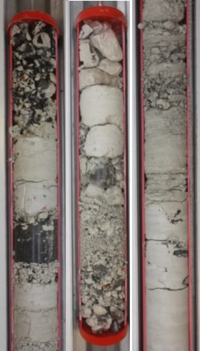Difference between revisions of "Geology and properties of limestone"
m |
m |
||
| Line 1: | Line 1: | ||
== Geology and hydrogeology == | == Geology and hydrogeology == | ||
| − | [[File:GeologicSequenceGEUS2014.png|thumb|200px|Geologic sequence. From: GEO and GEUS (2014), Strøming og stoftransport i kalklagene på den københavnske vestegn.]] | + | [[File:GeologicSequenceGEUS2014.png|thumb|200px|Fig. 1: Geologic sequence in eastern Denmark. From: GEO and GEUS (2014), Strøming og stoftransport i kalklagene på den københavnske vestegn.]] |
| − | [[File:BoreholeCores.png|thumb|200px|Borehole cores from the Akacievej field site.]] | + | [[File:BoreholeCores.png|thumb|200px|Fig. 2: Borehole cores from the Akacievej field site.]] |
| − | Limestone geologies | + | Limestone geologies are often heavily fractured and can include almost impermeable chert layers and nodules. |
| − | + | In such fractured limestone geologies, flow predominantly occurs in the fractures due to a much higher hydraulic conductivity as in the limestone matrix, which typically has a very low hydraulic conductivity. | |
| − | The limestone found at the Akacievej site is a carbonated sand limestone (Copenhagen chalk) | + | |
| + | The limestone found at the Akacievej site is a carbonated sand limestone (Copenhagen chalk) on top of a bryozoan limestone, both with a strongly varying hardness. | ||
| + | Figure 2 shows come cores from boreholes from the Akacievej site, which illustrate the heterogeneity of the limestone there. | ||
Due to glacial activity, the uppermost 1-5 meters of the limestone are crushed. | Due to glacial activity, the uppermost 1-5 meters of the limestone are crushed. | ||
A good description of the geologic stratification is given in the Report <ref> Geo/Geus, ''Geologi'', (Copenhagen, 2014)</ref> (in Danish). | A good description of the geologic stratification is given in the Report <ref> Geo/Geus, ''Geologi'', (Copenhagen, 2014)</ref> (in Danish). | ||
| − | The | + | The Figure 1 shows the typical krono-, bio- and lithostratigraphy in eastern Zealand (Denmark) and Øresundsregion. |
== Properties of limestone == | == Properties of limestone == | ||
Revision as of 11:41, 7 February 2017
Geology and hydrogeology
Limestone geologies are often heavily fractured and can include almost impermeable chert layers and nodules. In such fractured limestone geologies, flow predominantly occurs in the fractures due to a much higher hydraulic conductivity as in the limestone matrix, which typically has a very low hydraulic conductivity.
The limestone found at the Akacievej site is a carbonated sand limestone (Copenhagen chalk) on top of a bryozoan limestone, both with a strongly varying hardness. Figure 2 shows come cores from boreholes from the Akacievej site, which illustrate the heterogeneity of the limestone there. Due to glacial activity, the uppermost 1-5 meters of the limestone are crushed. A good description of the geologic stratification is given in the Report [1] (in Danish). The Figure 1 shows the typical krono-, bio- and lithostratigraphy in eastern Zealand (Denmark) and Øresundsregion.
Properties of limestone
The sorption behavior for chlorinated solvents on limestone was examined in Salzer (2013). For chlorinated solvents like PCE, sorption to limestone can be strong (kd values of 0.5-1 L/kg were observed). The following table gives an overview of values that were determined for the Akacievej site:
| Parameter | Value | Comment |
|---|---|---|
| K_crushed | 5x10^-4 m/s | crushed limestone conductivity |
| n_matrix | 0.10 - 0.20 | matrix porosity |
| Ap | 2 mm | typical fracture aperture |
| K_matrix | 1x10^-7 m/s | limestone conductivity |
| B | 20 - 25 m | aquifer thickness |
| D_m | 7.5x10^-7 m^2/s | effective diffusivity |
| k_d | 0.5-1.0 L/kg | sorption coefficient for PCE on limestone |
- ↑ Geo/Geus, Geologi, (Copenhagen, 2014)

